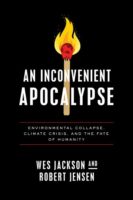 An Inconvenient Apocalypse: Environmental Collapse, Climate Crisis, and the Fate of Humanity
An Inconvenient Apocalypse: Environmental Collapse, Climate Crisis, and the Fate of Humanity
By Wes Jackson and Robert Jensen
184 pp. University of Notre Dame Press, Sept. 2022. $24.00.
The goal of An Inconvenient Apocalypse isn’t to try to convince people of the reality of humankind’s environmental and societal crises. The book’s authors know that’s a fool’s errand, given the powerlessness of facts alone to change minds. “A parade of statistics and studies,” they write, “rarely persuades those who have decided to ignore the threats to human communities and ecosystems.” Instead the book takes these threats as a starting point and spends the majority of its lean page count exploring their implications and how we might best respond to them. It succeeds commendably in this regard.
Authors Wes Jackson and Robert Jensen certainly have the bona fides to write authoritatively on the topic of this book. Jackson is a pioneer of sustainable agriculture and an all-around sustainability icon. Jensen is a professor emeritus of journalism and media at the University of Texas at Austin, as well as a longtime collaborator and coauthor with Jackson on sustainability-related issues. Like all their previous books together, this one is founded on a recognition of the obvious but widely denied reality that Earth is finite, and that humans have to learn to live within its limits. Write the authors, “[W]e take seriously the biophysical limits of the ecosphere and human limits.”
Unfortunately, most readers are likely to misinterpret the book’s title. That’s because the word apocalypse has come to be equated in popular parlance with the end of the world. But Jackson and Jensen are using it in its traditional sense, which they paraphrase as follows: “a lifting of the veil, a disclosure of something hidden from most people, a coming to clarity.” Understood in this sense, it’s perfect to describe the change in consciousness needed for humanity to make meaningful movement toward sustainability. Still, it’s regrettable that those who aren’t familiar with this meaning of apocalypse are likely to dismiss this book as alarmist or fatalist. (To the authors’ credit, their original title, The Old Future is Gone, would have been much less prone to such connotations; alas, it was rejected by the publisher on the grounds of its poor search engine optimization value, according to Jensen in interviews.)
The authors make a crucial clarification early on in the book, namely to whom they’re referring when they use the word “we” in the context of humanity’s ecological predicament. They don’t use it to mean citizens of high-consuming industrial nations, as many others do; instead, they use it to refer to every human alive today. They go on to explain that while the industrial world certainly is responsible for the majority of today’s resource consumption and consequent environmental impacts, the path that has led us to this state of affairs is rooted in humanity’s species-wide tendency to seek out ever more energy-dense fuel sources.
Philosopher Bill Vitek calls this propensity of ours our “human-carbon nature.” As that phrase suggests, Vitek contends that our affinity for relentlessly exploiting every last source of carbon on Earth—from soils to forests to fossil fuels—is an essential part of human nature. And Jackson and Jensen build on this contention to argue that “while not every individual or culture is equally culpable, the human failure over the past ten thousand years is the result of the imperative of all life to seek out energy-rich carbon.” Ten thousand years ago is when humans invented agriculture and thus first began extracting carbon beyond replacement levels. Ever since then, we’ve been on an ever-escalating carbon binge.
In a chapter aptly titled “Four Hard Questions,” Jackson and Jensen do a fine job of bringing into focus the true dimensions of the change our species must make. The titular questions are size, scale, scope and speed. By size the authors mean the maximum sustainable size of the human population. In the absence of modern fossil-fueled technology, they estimate this number to be a fraction of the planet’s present 8 billion. They acknowledge the taboo surrounding the topic of human population, but stress that we must be willing to discuss it nonetheless if we’re to avoid flying blindly into the population contraction that lies ahead as we lose access to the energy resources that have temporarily enabled today’s bloated population.
Scale, scope and speed refer, respectively, to the natural size limit of human social groups, the maximum technological level of a sustainable industrial infrastructure and the speed with which humanity must undergo its transition toward a sustainable society. The authors cite 150 people as the natural size limit of a human community, a figure rooted in human cognitive capacity and known as “Dunbar’s number.” They argue compellingly for an industrial infrastructure that is technologically simpler and far less energy-intensive than today’s. As for the speed with which we must shift our society onto a sustainable path, they say we need to do so “faster than we have been and faster than it appears we are capable of.”
Of course, many people stoutly believe that no such shift will be necessary, because technology and progress will somehow rescue our modern industrial way of life and allow it to continue indefinitely. Jackson and Jensen reiterate the oft-remarked observation that this belief amounts to a religious conviction. Borrowing a term from environmental author and thinker David Orr, they call it “technological fundamentalism,” defined in this book as “a religious-style faith in the ability of societies to solve problems with high energy and high technology, including the problems created by past use of that energy and technology.”
Adherents of this faith often point to feats such as humanity’s successful bid to save the ozone layer from ozone-depleting chlorofluorocarbons (CFCs) in the late 20th century as evidence that their faith is warranted. But the authors are quick to counter that the replacements for CFCs—hydrofluorocarbons (HFCs) and hydrochlorofluorocarbons (HCFCs)—have themselves had to be replaced following the discovery of their catastrophic global warming potential. It is the tale of so many supposedly miracle technologies of our time.
Jackson and Jensen insist they aren’t nihilists, and indeed they offer plenty of suggestions for constructive action. The common feature of these suggestions is that they all involve a radical shift in our values and ways of thinking about ourselves and the natural world. They call for a new paradigm in which we accept the finite nature of planet Earth and our status as animals that crave energy-dense carbon sources. They demand that we drastically reduce our numbers, scale down our living arrangements and levels of social organization, and redefine what a good life is. They also entail a reenvisioning of the appropriate role of alternative energy resources, which are to be used not to prop up our current way of life, but to cushion our inevitable descent to a lower-energy society.
The authors have coined the term “ecospheric grace” to describe their vision of an ideal orientation toward the natural world. To show ecospheric grace is to humble ourselves before the rest of nature. It is to accept that we humans aren’t at the center of everything, that we’ll never completely understand the natural world of which we’re a part and that nature doesn’t favor us over any other species. It is thus also to reject the ideal of Earth stewardship, since stewardship implies authority and control. Our goal should instead be to return the biosphere’s favor of “the gift of life with no strings attached” by treating it well.
An Inconvenient Apocalypse excels at making difficult concepts easily understandable through skillful use of thought experiments. In one, we’re asked to imagine how history might have unfolded differently had the contiguous United States, rather than western Europe, been blessed with the conditions that first paved the way for the industrial revolution. In another, we’re given a scenario in which socialism, instead of capitalism, established itself as the dominant economic system of the industrial world. Both of these thought experiments make crucial points about the reality of geographic determinism in history and humanity’s susceptibility to “the temptations of dense energy,” and they do so in a simple, accessible manner.
No doubt there are many who will never accept the message or core tenets of An Inconvenient Apocalypse, so deep is their attachment to the lifestyles and amenities of our era. But for those who are able to brush the proverbial scales from their eyes, this book will serve as a useful guide to the starkly different future we face in the decades and generations ahead.






